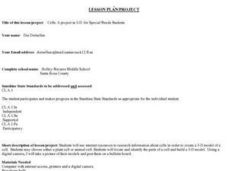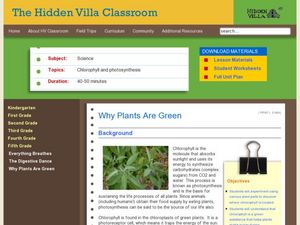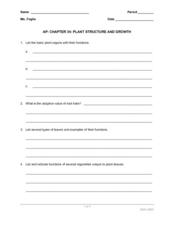Curated OER
Photosynthesis and Cell Respiration
Fifth graders participate in scientific inquires regarding the concepts of photosynthesis and cell respiration. In this photosynthesis and cell respiration lesson, 5th graders describe the process of photosynthesis with relation to...
Curated OER
MAKING THREE DIMENSIONAL PLANT AND ANIMAL CELLS
Students create two different cells, one plant and one animal. In this plant and animal cell lesson students form groups and construct a part of a cell. Students then put them all together to form one plant or animal cell.
Curated OER
Cell Pizza
Students identify parts and functions of microscope. Students watch video, Cells and Life about cell parts with actual pictures and actual cells. Students discuss video and identify parts of the cells that animals and plants have in...
Curated OER
Plant Cell Diagram
In this plant cell diagram worksheet, students use the blank space to draw a plant cell and label it. There is a word bank of 11 parts of the cell which should be labeled.
Curated OER
Green Plants
Beginning botanists are introduced to the world of plants with this PowerPoint. Some of the information is most appropriate for primary learners, such as the needs of a plant. Some of the information, however, is more directed at...
Curated OER
Lesson 2: the Cell Cycle
Students explain how cells reproduce. In this biology lesson, students explain the different stages of the cell cycle. They calculate the number of new cells produced.
Teach Engineering
Breathing Cells
Pairs work together to determine whether unknown solutions are either acids or bases by using a red cabbage indicator solution. After determining the general pH of the unknown solution, classmates blow into the same indicator after...
Curated OER
Parts Wanted: Advertising for Cell's Organelles
Seventh graders name the parts of the cell. Students demonstrate knowledge of the parts of a cell in reference to cell functions. They apply their knowledge of the cell and the cell parts to a real world situation.
Curated OER
Cells: A project in 3-D for Special Needs Students
Middle schoolers use the internet to research information about cells in order to create a 3-D model of a cell. They may choose either to research a plant or animal cell. Students locate and identify the parts of a cell and build a 3-D...
Curated OER
Parts of the Plant and Their Functions
Delving into this slideshow will help the students understand the composition of plants and their structures. Each slide identifies certain structures and explores how they support the plant's survival along with assisting our...
Columbus City Schools
You Can’t Sneeze On This Tissue
Take your class' understanding of cells to the next level... or levels! Demonstrate the levels of organization using a variety of engaging methods. The teacher's guide includes the materials you'll need to execute a flower dissection,...
Curated OER
Raven Chapter 37 Guided Notes: Plant Transport
Introduce botany or biology beginners to nutrient transport in plants by assigning this worksheet. Learners describe turgor pressure and its role in hydroregulation. They explain the functions of xylem, phloem, stomata, and guard cells....
Curated OER
Why Plants Are Green
Students discover the properties of chlorophyll in plants. In this plant biology lesson, students conduct an experiment to find where the chlorophyll in the plant is located. Students are split into small groups and study plant parts....
Curated OER
Cell 7 Plant v Animal Cells
Students differentiate between plant and animal cells. They identify the structures central to plant cells. They complete a Venn Diagram listing the differences between animal and plant cells.
Curated OER
WHAT IS A CELL?
Students explore the function and structures of cells, including plant and animal cells. They explore cell parts including cell wall, ribosomes, chromosomes, nucleoid, plasmids, flagella, pilli, and plasma membrane, cel
LABScI
Photosynthesis: How Do Plants Get Energy?
Examine the mechanism of photosynthesis through different light scenarios. Pupils vary the amount and type of light exposure on plant leaves in the fifth lesson plan in a 12-part series. Through observation, they determine the rate of...
Curated OER
AP: Chapter 35: Plant Structure and Growth
A straightforward learning exercise has botanists list plant organs and functions, plant cell organelles and their functions, specialized plant tissues and their functions. Three high-quality diagrams are displayed for them to label as...
Curated OER
Bee Pollen Popular
The world would be a much different place without the help of pollinators. Read about the important role bats, hummingbirds, and various insects play in plant reproduction, exploring the interdependence of living things in an ecosystem....
Curated OER
Parts of a Plant Cell and Their Functions
In this plant cell activity worksheet, students examine the diagram of a plant cell and label the 7 parts that are identified.
Curated OER
Plants And Pollination
Students describe sexual reproduction in plants, including the process of pollination, how insects assist in pollination, and how pollination differs from fertilization. They also explore the importance of honey bees to Arizona agriculture.
Curated OER
Parts of the Seed
In this biology worksheet, students read about the parts of plant seeds and look at a seed diagram. They read about the roots, endosperm, embryo, and the process of germination. They answer 8 online multiple choice questions based on the...
Curated OER
Plant Cell Coloring
In this plant cell worksheet, students sharpen their science skills as they color the parts of a plant cell according to the instructions and then respond to 4 analysis questions.
Curated OER
Charlie and the Cell City
Students identify the major components of the cell and their functions. They compare and contrast the major components and functions of animal and plant cells
Curated OER
Quiz Questions - Cells
In this cells instructional activity, students read and choose the multiple choice answers to 20 questions involving cells, microscopes, and the life process of Growth.

























